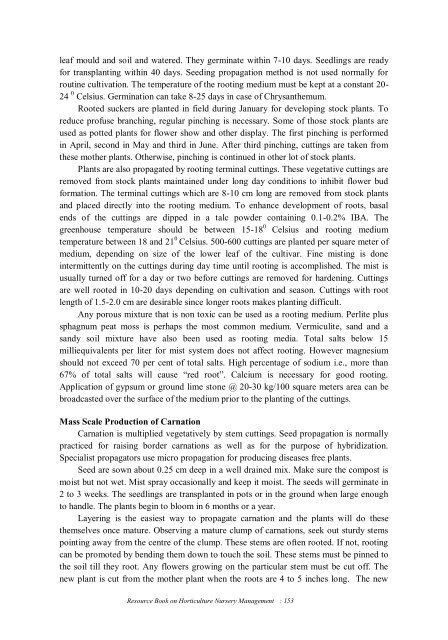Resource Book on Horticulture Nursery Management
Resource Book on Horticulture Nursery Management
Resource Book on Horticulture Nursery Management
You also want an ePaper? Increase the reach of your titles
YUMPU automatically turns print PDFs into web optimized ePapers that Google loves.
leaf mould and soil and watered. They germinate within 7-10 days. Seedlings are ready<br />
for transplanting within 40 days. Seeding propagati<strong>on</strong> method is not used normally for<br />
routine cultivati<strong>on</strong>. The temperature of the rooting medium must be kept at a c<strong>on</strong>stant 20-<br />
24 0 Celsius. Germinati<strong>on</strong> can take 8-25 days in case of Chrysanthemum.<br />
Rooted suckers are planted in field during January for developing stock plants. To<br />
reduce profuse branching, regular pinching is necessary. Some of those stock plants are<br />
used as potted plants for flower show and other display. The first pinching is performed<br />
in April, sec<strong>on</strong>d in May and third in June. After third pinching, cuttings are taken from<br />
these mother plants. Otherwise, pinching is c<strong>on</strong>tinued in other lot of stock plants.<br />
Plants are also propagated by rooting terminal cuttings. These vegetative cuttings are<br />
removed from stock plants maintained under l<strong>on</strong>g day c<strong>on</strong>diti<strong>on</strong>s to inhibit flower bud<br />
formati<strong>on</strong>. The terminal cuttings which are 8-10 cm l<strong>on</strong>g are removed from stock plants<br />
and placed directly into the rooting medium. To enhance development of roots, basal<br />
ends of the cuttings are dipped in a talc powder c<strong>on</strong>taining 0.1-0.2% IBA. The<br />
greenhouse temperature should be between 15-18 0 Celsius and rooting medium<br />
temperature between 18 and 21 0 Celsius. 500-600 cuttings are planted per square meter of<br />
medium, depending <strong>on</strong> size of the lower leaf of the cultivar. Fine misting is d<strong>on</strong>e<br />
intermittently <strong>on</strong> the cuttings during day time until rooting is accomplished. The mist is<br />
usually turned off for a day or two before cuttings are removed for hardening. Cuttings<br />
are well rooted in 10-20 days depending <strong>on</strong> cultivati<strong>on</strong> and seas<strong>on</strong>. Cuttings with root<br />
length of 1.5-2.0 cm are desirable since l<strong>on</strong>ger roots makes planting difficult.<br />
Any porous mixture that is n<strong>on</strong> toxic can be used as a rooting medium. Perlite plus<br />
sphagnum peat moss is perhaps the most comm<strong>on</strong> medium. Vermiculite, sand and a<br />
sandy soil mixture have also been used as rooting media. Total salts below 15<br />
milliequivalents per liter for mist system does not affect rooting. However magnesium<br />
should not exceed 70 per cent of total salts. High percentage of sodium i.e., more than<br />
67% of total salts will cause “red root”. Calcium is necessary for good rooting.<br />
Applicati<strong>on</strong> of gypsum or ground lime st<strong>on</strong>e @ 20-30 kg/100 square meters area can be<br />
broadcasted over the surface of the medium prior to the planting of the cuttings.<br />
Mass Scale Producti<strong>on</strong> of Carnati<strong>on</strong><br />
Carnati<strong>on</strong> is multiplied vegetatively by stem cuttings. Seed propagati<strong>on</strong> is normally<br />
practiced for raising border carnati<strong>on</strong>s as well as for the purpose of hybridizati<strong>on</strong>.<br />
Specialist propagators use micro propagati<strong>on</strong> for producing diseases free plants.<br />
Seed are sown about 0.25 cm deep in a well drained mix. Make sure the compost is<br />
moist but not wet. Mist spray occasi<strong>on</strong>ally and keep it moist. The seeds will germinate in<br />
2 to 3 weeks. The seedlings are transplanted in pots or in the ground when large enough<br />
to handle. The plants begin to bloom in 6 m<strong>on</strong>ths or a year.<br />
Layering is the easiest way to propagate carnati<strong>on</strong> and the plants will do these<br />
themselves <strong>on</strong>ce mature. Observing a mature clump of carnati<strong>on</strong>s, seek out sturdy stems<br />
pointing away from the centre of the clump. These stems are often rooted. If not, rooting<br />
can be promoted by bending them down to touch the soil. These stems must be pinned to<br />
the soil till they root. Any flowers growing <strong>on</strong> the particular stem must be cut off. The<br />
new plant is cut from the mother plant when the roots are 4 to 5 inches l<strong>on</strong>g. The new<br />
<str<strong>on</strong>g>Resource</str<strong>on</strong>g> <str<strong>on</strong>g>Book</str<strong>on</strong>g> <strong>on</strong> <strong>Horticulture</strong> <strong>Nursery</strong> <strong>Management</strong> : 153











